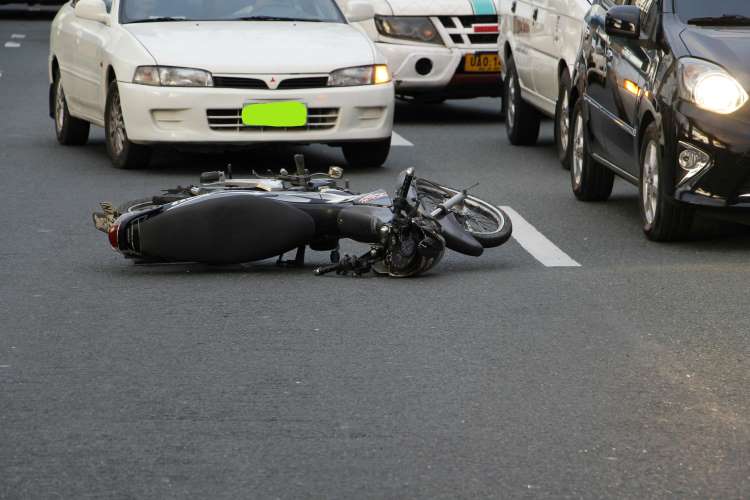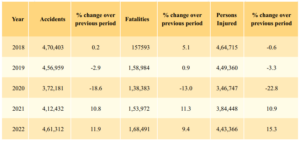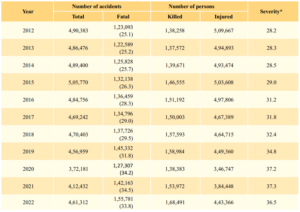
India has seen rapid growth in the automotive sector over the last few decades and is currently the fourth largest market in the world. The Indian automotive industry is supported by a 6.6 million kilometre road network which carries about 90% of the country’s passenger traffic and 65% of its goods. However, India has continued to demonstrate a lacklustre performance in terms of road safety standards.
In 2022 alone, over 460,000 road accidents were registered, resulting in 168,491 fatalities and 443,366 injuries. Road safety is heavily influenced by vehicle safety, including the safety of tires. Tire bursts are a significant cause of road accidents. In 2014, there were 9,748 accidents due to tire bursts, resulting in 3,371 deaths and 9,081 injuries.
READ I Road safety crisis: Infrastructure boom to public health emergency
Tyre blowouts and road safety
Approximately 15% of these accidents were due to tire blowouts, overturning, and skidding caused by overinflated tires. High-quality tires improve road grip and handling, reducing braking distance by up to 50%. In 30% of all road accidents resulting in personal injuries, high-quality tires could reduce collision speed and injury severity. About 5% of all accidents could be avoided with better tires.
Speeding, directly linked to tire safety, remains the predominant cause of road fatalities, accounting for 71% of total deaths in 2022. Overloading is another significant cause of tire bursts. In 2019, overloaded vehicles accounted for about 10% of total deaths and 8% of total crashes, killing 14,320 people. Uttar Pradesh ranks first in terms of crashes and deaths related to overloading.
Number of road accidents, fatalities during 2018-2022 period

Long-term trends in major parameters of road accidents (2012–2022)

Rising temperatures and hot climatic conditions in India lead to the expansion of tire air volume, contributing to the increasing incidents of tire bursts. In 2014, the Ministry of Road Transport and Highways (MoRTH) questioned the quality of tires produced in India following frequent accidents attributed to tire bursts. MoRTH decided to write to the Bureau of Indian Standards (BIS) to modify the existing tire specifications to align with global standards. They asserted that tire makers should be held responsible for accidents caused by tire bursts.
The physical nature of tires and their role in safety are critical. Tires are the only contact point between the vehicle and the road, affecting performance through drag force, friction, wear, pressure, noise, and overall functionality. They transmit torque, support vehicle load, provide friction for starting, stopping, and turning, and act as a suspension system, absorbing impacts and road irregularities.
Indian tire standards, mandatory since 2010, classify tires based on the type of vehicles they are designed for, including passenger cars, light commercial vehicles (LCV), heavy-duty vehicles (HDV), two- and three-wheelers, and off-the-road vehicles. In April 2022, BIS revised and updated these standards to incorporate global norms. The Central Motor Vehicles (Tenth Amendment) Rules, 2022, introduced new standards for rolling resistance, wet grip, and rolling sound emissions for various tire classes, aligning India with United Nations Economic Commission for Europe (UNECE) regulations.
Need performance parameters
While Indian tire standards specify safety, durability, and dimensions, they do not cover performance parameters such as rolling resistance, wet grip, external noise, internal noise, and braking performance. Many Indian tire manufacturers comply with global norms, but mandatory BIS benchmarks have not fully achieved the objective of holding tire makers accountable for failures and recalls, unlike regulations in the US, EU, China, South Korea, Japan, and Australia.
The Indian tire market has been growing consistently, with an estimated size of 185.42 million units in 2022. It is projected to grow at a CAGR of 5.54%, reaching 256.24 million units by 2029. The highest demand is from two- and three-wheelers, which account for about 52% of tires produced. The industry also generates significant revenue from exports, with Indian tires being exported to over 100 countries. The US remains the largest market for Indian tires, accounting for 17% of total exports in 2022.
The industry comprises 11 key players registered with the Automotive Tyre Manufacturers Association (ATMA), including Apollo Tyres Ltd., Birla Tyres, Ceat Ltd., Bridgestone India Pvt. Ltd., Continental India Ltd., Goodyear India Ltd., JK Tyre & Industries Ltd., Michelin India Pvt. Ltd., MRF Ltd., TVS Srichakra Ltd., and Yokohama India. These companies account for over 90% of the industry size in value terms.
The Indian government has taken several policy and standard-setting measures to ensure vehicle and tire safety. The MoRTH has proposed mandatory compliance with new norms for rolling resistance, wet grip, and rolling sound emissions since October 2022. These norms will pave the way for “star rating” or “labelling” of tires in India.
Consumer sensitisation is key to improving road safety. Road safety is a behavioural issue, with most accidents caused by driver or vehicle user error. Therefore, it is crucial for tire manufacturers, original equipment manufacturers (OEMs), and vehicle manufacturers to engage consumers in awareness initiatives.
Critical issues that need consumer awareness include the link between speeding and tire bursts, the importance of proper tire inflation, and the dangers of worn-out tires. Research and impact assessments on policies, standards, practices, and implementation status are essential. Long-term interventions focusing on consumer behaviour and practices towards tire and vehicle safety are needed at national, state, and district levels.
There is an urgent need for policy initiatives to include tire-related accident information at state and national levels. Tire manufacturers should start comprehensive consumer sensitisation campaigns about tire safety, maintenance, usage norms, and standards. Properly inflated tires are essential for safety, and drivers must be aware of the risks of over-inflated and under-inflated tires.
Increasing consumer awareness about preventive measures for tire and vehicle safety, coupled with policy initiatives addressing speeding and tire-related issues, can significantly reduce road crashes in India.
(Madhu Sudan Sharma is Senior Programme Officer and Varidhi Singh is Advisor at CUTS International, a leading policy research and advocacy group.)
